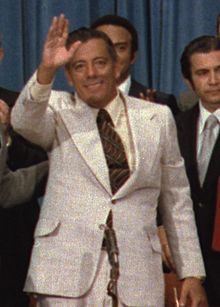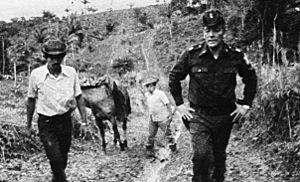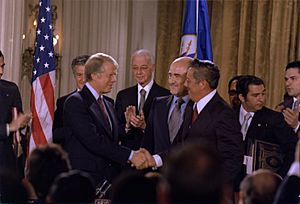Omar Torrijos facts for kids
Quick facts for kids
Maximum Leader of
the Panamanian Revolution Omar Torrijos
|
|
|---|---|

Torrijos in 1978
|
|
| Military Leader of Panama | |
| In office October 11, 1968 – July 31, 1981 |
|
| President | José María Pinilla (1968–69) Demetrio Lakas Bahas (1969–78) Arístides Royo (1978–82) |
| Preceded by | Arnulfo Arias (President) |
| Succeeded by | Florencio Flores |
| Personal details | |
| Born |
Omar Efraín Torrijos Herrera
February 13, 1929 Santiago, Panama |
| Died | July 31, 1981 (aged 52) near Penonomé, Panama |
| Resting place | Torrijos Mausoleum Amador, Panama City, Panama |
| Political party | Democratic Revolutionary Party (1979–1981) |
| Spouse | Raquel Pauzner de Torrijos |
| Children | 3 |
| Occupation | Military Officer |
| Signature |  |
| Military service | |
| Allegiance | |
| Branch/service | National Guard of Panama |
| Years of service | 1950-1981 |
| Rank | General |
Omar Efraín Torrijos Herrera (February 13, 1929 – July 31, 1981) was a military leader in Panama. He served as the Commander of Panama's National Guard from 1968 until his death in 1981. Although he was never officially the President of Panama, he held the title "Maximum Leader of the Panamanian Revolution." Torrijos came to power through a military takeover and introduced many social changes.
He is most famous for working out the 1977 Torrijos–Carter Treaties. These agreements eventually gave Panama full control over the Panama Canal. The treaties ensured that Panama would take over the Canal after 1999. This ended the control the U.S. had held since 1903. On December 31, 1999, the U.S. officially handed over the Panama Canal and all related areas.
His son, Martín Torrijos, later became President of Panama, serving from 2004 to 2009.
Contents
Early Life and Military Career
Torrijos was born in Santiago, a city in the Veraguas province. He was the sixth of eleven children. His father, José Maria Torrijos, was a teacher from Colombia. Omar went to the Juan Demóstenes Arosemena School.
At 18, he earned a scholarship to a military academy in San Salvador. He graduated as a second lieutenant. In 1952, he joined the Panamanian army, known as the National Guard. He quickly rose through the ranks, becoming a captain in 1956 and a major in 1960. He also attended a cadet course at the School of the Americas in 1965. By 1966, he was the Executive Secretary of the National Guard.
Rise to Power
By 1966, Torrijos had become a lieutenant colonel. In 1968, his close friend, Major Boris Martínez, led a military takeover against Panama's newly elected president, Arnulfo Arias. Torrijos joined the effort to establish a new government.
Soon after the takeover, Torrijos was promoted to full colonel. He was named commandant of the National Guard. The new leaders stopped all political activities and closed the legislature. They also took control of several newspapers. In February 1969, Torrijos removed Martínez from power and sent him out of the country. This made Torrijos the main leader of Panama.
Leading Panama
Torrijos believed his revolution was "for the poor." He worked to help ordinary people, not just the wealthy. He introduced a new Constitution, changed land ownership rules, and created a new Labor Code. He also supported workers' and farmers' unions.
His government started many projects to help people. They built new schools and created jobs. They also gave agricultural land to farmers who didn't own any. This was one of his most popular actions. His government also invested in large public works projects. He challenged big international companies and gave back 180,000 hectares of unused land to the people.
In 1972, a new assembly was formed, and a new Constitution was approved. This document made Torrijos the actual head of government. He had strong powers for six years. Many people saw Torrijos as the first Panamanian leader who truly represented the majority of the population. These were often poor, Spanish-speaking people of mixed heritage. He worked to improve the lives of those less fortunate.
In international matters, Torrijos supported leaders like Salvador Allende of Chile. He also welcomed refugees from Chile after a military takeover there in 1973. He helped rebel groups in Nicaragua, El Salvador, and Guatemala. He also restarted diplomatic relations with Cuba.
In 1978, Torrijos stepped down as the official head of government. However, he remained the country's real leader. Another of his supporters, Aristides Royo, became a figurehead president. Torrijos also brought back some civil liberties. This was partly because U.S. President Jimmy Carter said the U.S. Senate would not approve the Canal treaties unless Panama became more open.
The Panama Canal Treaties
Torrijos was inspired by other leaders who fought for their country's independence. He began a long effort to gain Panama's full control over the Panama Canal from the United States. In 1973, he brought the issue to the United Nations. He stated that Panama would never be a colony or protectorate of the U.S.
He successfully negotiated the Torrijos-Carter Treaties, which were signed on September 7, 1977. These treaties transferred control of the Canal Zone from the United States to Panama. Panama gradually gained more control, leading to complete control on December 31, 1999. The United States kept the right to protect the Canal's neutrality.
Political Changes
Under pressure from the U.S. and facing economic challenges, Torrijos worked to ease public concerns. He brought back traditional political parties by changing the 1972 constitution. He also set elections for 1984. In 1979, Torrijos created the Democratic Revolutionary Party (PRD). This party aimed to unite different social groups. Torrijos was key to keeping the party's different ideas working together. His death in 1981 happened before these political changes were complete. This led to a difficult time in Panama's politics.
Personal Life
Omar Torrijos was generally seen as a friendly person. He married Raquel Pauzner in 1954, and they had three children. He often spent his weekends with farmers in the countryside. He had several homes, including a beach house and a house in Coclesito.
He was described as humble and respectful. He often listened to the problems of middle and lower-class people.
Death
Omar Torrijos died at age 52 on July 31, 1981. His plane, a de Havilland Canada DHC-6 Twin Otter, crashed at Cerro Marta in Coclesito, Panama. The plane disappeared from radar during light bad weather. Because Panama's radar coverage was limited then, the plane wasn't reported missing for almost a day.
The crash site was found several days later. Torrijos's body was recovered in early August. Four of his assistants and two pilots also died in the crash. His death caused great sadness across the country, especially among poorer communities. After a large state funeral, Torrijos was buried in a mausoleum in the former Panama Canal Zone near Panama City.
After his death, there were claims and ideas that he was killed. Some people, including his cousin Roberto Diaz, have accused the United States or other figures of being involved in his death. However, these claims remain unproven. The crash site is now a national park, and his house in Coclesito is a museum.
Foreign Honours
 Belize:
Belize:
 Cuba:
Cuba:
 Peru:
Peru:
 Spain:
Spain:
 Collar of the Order of Civil Merit (1977)
Collar of the Order of Civil Merit (1977)
See also
 In Spanish: Omar Torrijos Herrera para niños
In Spanish: Omar Torrijos Herrera para niños
- José de Jesús Martínez
- List of unsolved deaths
- Manuel Noriega
- Martín Torrijos
- Panama Canal Zone
- Tocumen International Airport
- Torrijos-Carter Treaties
- Getting To Know The General: The Story of an Involvement




